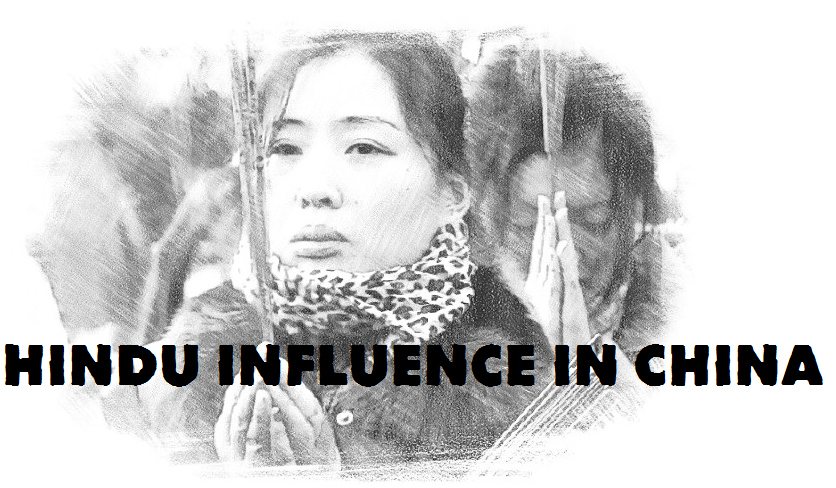Hinduism in China: Influence that goes back many millennia

Hu Shih, former Ambassador of China to USA once said “India conquered and dominated China culturally for 20 centuries without ever having to send a single soldier across her border.” In Spiritual and Philosophical terms, that is very true. You can either include the other in yourself by Conquering, or by Embrace. What Hu Shih talks about was the inclusion by Embrace.
For a world which is high on Religion, and which believes that philosophy is central to Spiritual pursuits (which is utter nonsense, but oh well!); Buddhism is distinct and an intriguing product from India.
Buddhism, first and foremost, is not a religion. It is a Spiritual discipline which has many paths experienced and taught by various Enlightened Beings. Spiritually relevant paths are neither unique nor exclusive. Buddha appeared on the Indian scene many thousands of years after Yoga and Spiritual disciplines had been perfected and taught. He was an incredible and an amazing being. But what he perfected wasn’t unique. And, that is why it is my argument that Buddhism – as a distinct “Religion” – never survived in India. There was no difference. The work done prior to and after Buddha in Spiritual realm has been so enormous in India, that his work – incredible and amazing in its own way – wasn’t able to maintain much distinction.
And, no – Hindus did not “persecute” Buddhists to eliminate them. Except for one king’s rivalry with his neighbor, who happened to be a Buddhist, there is no other evidence of such a conflict. Yes, those who became fanatic Buddhists – without Spiritual foundation – like Ashoka, did go about demonstrating their fanaticism and killing others after taking on Buddhist “way of life” (ironical!). [“Ashoka the Great” was India’s first Religiously fanatic Jehadi]
The Indian Spiritual practices – which have been collectively known as Sanatana Dharma – or by the Religious as “Hinduism” – have had a long and credible history of work. The entire world of Yoga – which goes beyond the tough postures – has been prevalent since many millennia. Nothing that has been done in Spirituality hence has been outside of that work. And, such work has never been the property of one person. It has been learnt and taught in a systematic and deliberate way by every Teacher to his / her Students. The Guru-Shishya methodology has survived many millennia. The Boddhisatvas and the Buddhist monks have followed a similar methodology everywhere they went.
China, Hinduism and Indian Spirituality

China as a distinct geographical entity has been mentioned in Hindu Scriptures since a long time. China had been called Cina in Mahabharat for example. Interestingly, people from Cina came along with the Kiratas (people from modern day Nepal) to join the Army of Bhagadatta of Pragjyotisa or modern day Assam.
Later on, when the Pandavas go to the Himalayas after the war, they go all the way near Badrinath and cross over into the land of Cina via the kingdom of Kirata king Subahu.
This interaction between Indian and the Chinese people has gone on for a long time since then. The flow of Spirituality and even philosophy happened during these years as well.
Some say that the impact of the concept of Yakshas and the Hanuman (in the Chinese character Sun Wukong) is very visible in many Chinese folk lores.
But interestingly it was in the the last millennia that the Hindus went over in China and created temples, which have stood all these years and still being used in some cases.
In an interesting story by “The Hindu” newspaper correspondent, Ananth Krishnan, there are temples in China which are still prayed to by the local residents. For example, in the village of Chedian, where a Goddess is still worshipped as a form of Guanyin, the female Bodhisattva. The article quotes a local resident, Li San Long, saying “This is possibly the only temple in China where we are still praying to a Hindu God” .
This temple is not an isolated example, but possibly a part of the larger network of temples that were created by Indian – possibly Tamil – traders over a thousand years ago.
The Chedian shrine is just one of what historians believe may have been a network of more than a dozen Hindu temples or shrines, including two grand big temples, built in Quanzhou and surrounding villages by a community of Tamil traders who lived here during the Song (960-1279) and Yuan (1279-1368) dynasties.
Similarly, in Thailand, Phra Phrom (derivative of “Vara Brahma”) is also worshipped as the four-faced Buddha. The worshippers regularly offer incense, candles, jasmine flowers or jasmine garlands and young coconut milk (with water in them) to the deity.
Intermingling and Merging of Buddhist and Hindu traditions
Just as the world of Spiritual paths coming off of the work of Buddha folded back into the larger Dharmic Spiritual paths within India; it is also interesting to see that the influences and practices usually associated with Hinduism have been merged with the larger Buddhist traditions and idiom in China and the surrounding areas influenced by Chinese culture.
To understand how easily translation of one’s devotion and practices in one Spiritual path to similar sentiment in another happens, can be seen in this interesting video which comes from Singapore. Here, a Buddhist and Hindu temple exist side by side and the worshippers from one go to another without any hesitation or a feeling of “loss of faith”. It is almost like a continuation of the same process.




